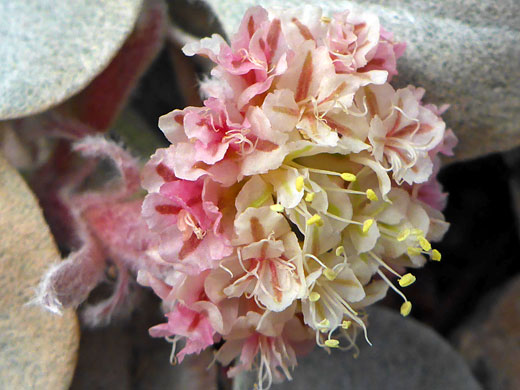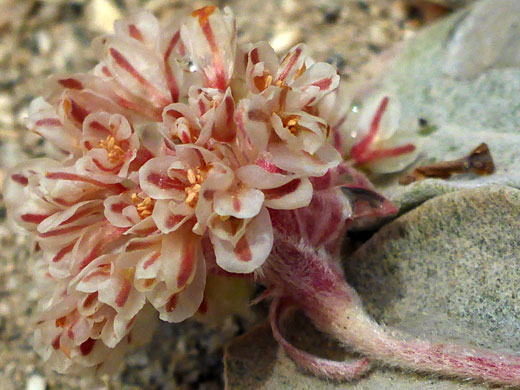Common name:
Granite buckwheat
Family:
Scientific name:
Eriogonum lobbii
Main flower color:
Range:
California, far southwest Oregon and west Nevada
Height:
Up to 12 inches
Habitat:
Sandy or gravelly places in mountainous habitats, from 5,000 to 12,500 feet. On granitic or serpentine soils
Leaves:
Broadly ovate to round, up to 1.6 inches long, moderately to densely tomentose; in basal rosettes
Season:
June to September
Eriogonum lobbii is one of the more distinctive buckwheat species; it has a dense, rounded, terminal cluster of flowers, subtended by a whorl of leaf-like bracts (three to five), on a leafless stalk from a basal leaf rosette. Flowers are initially white or pale yellow, maturing to orange then pink to red - often all colors are present at the same time. Tepals are ovate, and darker along the midvein. Stamens are exserted; they have thin white filaments and transverse yellow anthers. The reddish-pink involucres, around a third of an inch long, have six to ten triangular teeth along the upper margin, spreading to reflexed.
Plants can form small mats, with multiple stems; about one foot across. Stems tend to lay along the ground, turning up only at the tip. The stems have a covering of tomentose hairs, as do the the petiolate, rounded leaves, especially on the undersurfaces. Leaf margins are entire.
Plants can form small mats, with multiple stems; about one foot across. Stems tend to lay along the ground, turning up only at the tip. The stems have a covering of tomentose hairs, as do the the petiolate, rounded leaves, especially on the undersurfaces. Leaf margins are entire.
All Contents © Copyright The American Southwest | Comments and Questions | Contribute | Site Map





